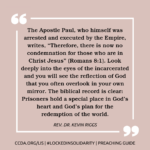An Interview with Wally Bryan of Challenge House
For most of the 1990s, Wally Bryan was mayor of Hopkinsville, Kentucky. After the turn of the millennium, he was in semi-retirement, living in what he calls the outer-city, and feeling “a little adrift.” He read Rick Warren’s Purpose Driven Life and John Eldredge’s Wild at Heart and was persuaded that he needed to do something new with his life. It was time to follow his passion. He was interested in “poverty and education and my faith” and was “drawn to the least of these that the scriptures talk about,” and he “wanted to be more connected with issues of racial reconciliation and being a neighbor to some people that I barely knew or didn’t know.”
So Wally moved to an apartment just a couple of miles away, becoming possibly the only Caucasian resident of a predominantly African-American neighborhood. After a while he and his partners opened the first Challenge House—sort of “a house church, a neighborhood school, and an area-wide work-over-welfare center.” Today there are two Challenge Houses, and by the end of the year there will be four.
I asked Wally to tell me the Challenge House story.
How did you land in the neighborhood where you started Challenge House?
On June 1, 2004, I moved from a historic neighborhood here in Hopkinsville to an area that was probably the lowest-income census tract in the city and nearly 100 percent African American. I moved into a little apartment, $225 a month and free roaches. I learned to hate those little buggers. That gives you an indication of the type of place I moved into: a roach-infested eight-plex in the middle of a very tough known drug area.
I was really a minority and needed to build relationships and trust. People thought it was a political stunt or an undercover police-type effort because I rode a bicycle a lot. It took a while for people to realize I was there to be a neighbor and a friend and to listen.
I stayed in that little apartment 40 months. I wasn’t as brave as Moses, who stayed 40 years.
When I had been there for about a month, one afternoon I was driving down the alley with the window rolled up and the a/c on. I saw a man washing an SUV and waved to him. I don’t know if he made a motion or said something to me, but when I stopped at the end of the alley and looked in the side mirror, he was staring at me.
I backed up, rolled down the window, and asked, “Were you trying to say something to me?”
He looked at me with boldness and said, “I don’t mean to be racist, but you have been in our community for about a month, and you always wave, but you never stop to talk. My name is Ray Smith, and my grandmother lives here and her name is Mary Smith.”
I said, “It took a lot of courage for you to say that to me. I needed to hear that. Thank you.” And I drove off.
A few days later I knocked on the door and met his grandmother. I go visit her almost every day. I bring her the paper, sometimes take a nap on the couch. Mary Smith is a wonderful example of how God picks someone within a neighborhood who is a holy woman full of joy who’s a wonderful connector. Youth groups, leadership classes, and countless individuals have come to her house and sat in her little living room and shared the gospel and prayer. She’s our spiritual director on the board of directors. At 85 she can’t get to the meetings, but her willingness to share her humble home has played a key role in outer-city people and inner-city people beginning to connect.
How did the first Challenge House get started?
During the time I was living in the apartment, I noticed a big house that at one time you could tell was a beautiful brick home, but was now almost ready for the bulldozer. We found out that Citi Financial Group had it in foreclosure. We contacted them and they ended up giving us the house. Nine thousand dollars was owed against it, but with God’s engineering we acquired the house for nothing.
At some point it came to be known as the Challenge House. I don’t know where the name came from. Someone had said it’s going to be a challenge to restore that old house to its former glory, to reseed the neighborhood with faith, to get people to live in the house, to build relationships across racial divides.
We had a nonprofit board of directors, and we had a lot of individual people who gave money, and what we were short we borrowed. I moved into the house. But I was also out among the people. If you’re really going to do what Dr. John Perkins says, you can’t just stay in the house.
How do daily living and ministry mix in the physical space and weekly schedule of a Challenge House?
Two of our houses have two stories, and the private living domain is upstairs. When you first wake up in the morning, the whole house is yours. At other times there are GED classes, Jobs for Life classes, after-school programs, and so on happening on the first floor. But what really matters is the organic relationships and things that just happen one on one or neighbor to neighbor. It snows and we go over and knock the snow off someone’s windshield, and a few minutes later we hear a noise and find out someone’s shoveled our sidewalk. Going next door and borrowing some butter instead of always people needing something from us. That’s what relocation is about more than the specific programs.
We don’t have signs that say Challenge House, but everyone knows where the Challenge House is. Some people have poker parties and Tupperware parties. We have Bible parties, GED parties, and work parties.
The first time I taught Sunday school at Challenge House was one Sunday afternoon when three children knocked on the door in the afternoon and asked for something to eat. I said, “Come back in 45 minutes. I’ll teach you about the Bible, and then I’ll get you something to eat. You can bring some friends with you.” Forty-five minutes later, the three had brought 15 more. We had a little lesson and I bought them pizza. Now we have Sunday school weekly at 2:00 p.m.
None of these kids had been going to Sunday school or church. The black church is like the white church: you drive in and drive home. This is the model of having a point of light and love right there close by. That’s the way it’s supposed to be.
What do you envision for the future of Challenge House?
One of the main purposes of a Challenge House is to make it easier for people of faith to relocate—to have a house waiting for them. There are two now. We’re about ready to open a third, and a fourth will open by the end of the year. The concept has caught on. Hopkinsville has a lot of pockets of poverty, and our vision is to have at least six Challenge Houses in our city in different neighborhoods so when people move from one neighborhood to another they’ll find a Challenge House. We want to have the synergism so when you move, it won’t be long before you hear, “Challenge House is over there.”
I think it definitely could be a reproduced concept. I don’t see why it wouldn’t work pretty much anywhere. It could work in bigger cities too. The concept is to form a nonprofit corporation and buy a house. The whole purpose is to make it easier for someone to relocate and help us learn. It would be neat if within each neighborhood more outer-city people came in and didn’t put bars on their windows and re-neighbored without being the center of attention. That’s what a Challenge House is.
You can visit Challenge House at challengehouse.org or call 270.886.8887.




